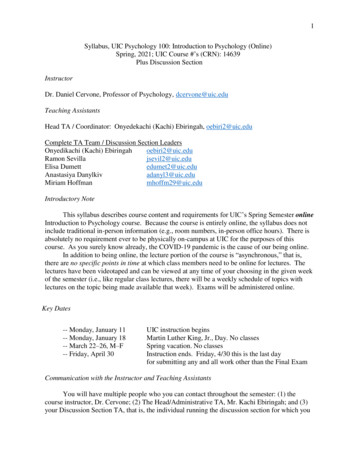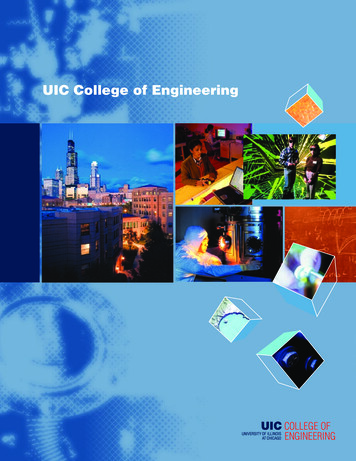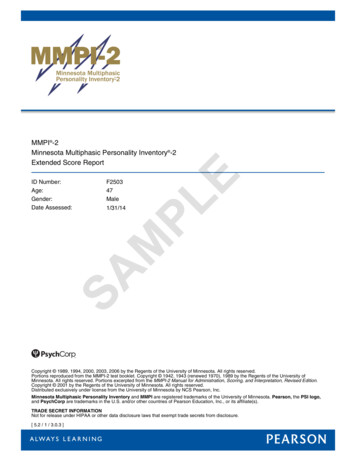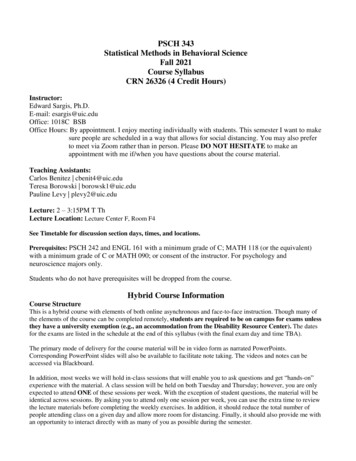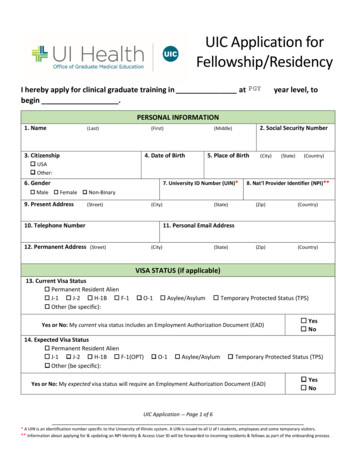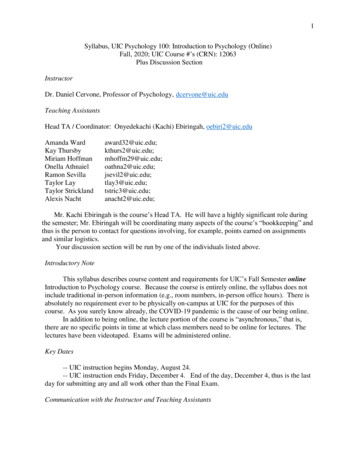
Transcription
1Syllabus, UIC Psychology 100: Introduction to Psychology (Online)Fall, 2020; UIC Course #’s (CRN): 12063Plus Discussion SectionInstructorDr. Daniel Cervone, Professor of Psychology, dcervone@uic.eduTeaching AssistantsHead TA / Coordinator: Onyedekachi (Kachi) Ebiringah, oebiri2@uic.eduAmanda WardKay ThursbyMiriam HoffmanOnella AthnaielRamon SevillaTaylor LayTaylor StricklandAlexis tstric3@uic.edu;anacht2@uic.edu;Mr. Kachi Ebiringah is the course’s Head TA. He will have a highly significant role duringthe semester; Mr. Ebiringah will be coordinating many aspects of the course’s “bookkeeping” andthus is the person to contact for questions involving, for example, points earned on assignmentsand similar logistics.Your discussion section will be run by one of the individuals listed above.Introductory NoteThis syllabus describes course content and requirements for UIC’s Fall Semester onlineIntroduction to Psychology course. Because the course is entirely online, the syllabus does notinclude traditional in-person information (e.g., room numbers, in-person office hours). There isabsolutely no requirement ever to be physically on-campus at UIC for the purposes of thiscourse. As you surely know already, the COVID-19 pandemic is the cause of our being online.In addition to being online, the lecture portion of the course is “asynchronous,” that is,there are no specific points in time at which class members need to be online for lectures. Thelectures have been videotaped. Exams will be administered online.Key Dates-- UIC instruction begins Monday, August 24.-- UIC instruction ends Friday, December 4. End of the day, December 4, thus is the lastday for submitting any and all work other than the Final Exam.Communication with the Instructor and Teaching Assistants
2You will have multiple people who you can contact throughout the semester: (1) thecourse instructor, Dr. Cervone; (2) The Head/Administrative TA, Mr. Kachi Ebiringah; and (3)your Discussion Section TA, that is, the individual running the discussion section for which youhave signed up. When you complete paper assignments (see below), your work will be gradedby your Discussion Section TA. This individual therefore is (in addition to your instructor, DC)a key contact for you throughout the semester.Contact the Instructor (please!). Your instructor, Dr. Cervone, will be availablethroughout the semester. Please feel free to email any and all course questions to me atdcervone@uic.edu. DC is also happy to set up video meetings for anyone who would like todiscuss any aspect of course content; please email me to set this up. I also recognize that, for agreat many of you, this will be your first semester at UIC, so please feel free to send moregeneral life-at-UIC questions, too.Course Content and GoalsCourse Content: Where is it?We will be making heavy use of the course’s Blackboard website for the delivery ofeducational content and for the overall administration of the course. The Blackboard website isintegrated with the UIC registration system; once you are in the course, you should automaticallyappear in the course website. The UIC website also is integrated with a website established bythe publisher. One of your options for getting the textbook, which you will need in electronicform, is to purchase the textbook through the UIC Blackboard site. (Details below).Course Content: When does it appear?A large number of course elements are timed; they occur in a given week of the semester.Those elements will appear on the Blackboard website during that week. For example, if we arecovering Developmental Psychology in Week 5, material such as quiz-yourself questions thatpertain to developmental psychology, or the “Try This” (see below) activity for DevelopmentalPsychology, will not be available until that week. The idea is that, just as is the case with an inperson course, class activities will be “synched” to the topic of the given week.The Substance: Course GoalsOur educational goal is to introduce you to the science of psychology. Since the ideaof “introducing” a subject is a little vague, we’ll spell it out. In this -- and almost any -introductory course, “introducing” means two things; you should, in other words, be able toanswer to two types of questions as a result of taking the course.(1) How do professionals in the field analyze whatever it is that they’re studying?How do they decide what problems to try to solve? How do they go aboutsolving them; what, in other words, are their research strategies?(2) What have these professionals learned?What are the field’s most important findings? How have basic-science
3discoveries been applied to socially-significant problems?In this course, we thus will cover the strategies of psychological science and the mainfindings in each major branch of the field.Readings and the TextbookAll required readings (note: you will need to do some additional reading for the paperassignments; see below) will come from our textbook: Psychology: The Science of Person,Mind, and Brain, Cervone (yes, that’s me, your course instructor).Do I Really Need this Book?The answer to “Do I really need this book?” is yes! Our textbook is the primary learningtool of this class; it contains much more information, in total, than could ever be presented inlectures. A great deal of material on the exams will be coming from the book. For learningpurposes, you will need the textbook in this class to the same degree that you would need the classtextbook in a course in, for example, mathematics.In addition to traditional textbook content, the e-book contains (a) a large amount ofpedagogical material (chapter reviews, test-yourself quizzes, etc.) written by the book’s pedagogicalauthor, Professor Tracy Caldwell of Dominican University, and (b) activities that are courserequirements, and for which you thus will earn credit. As is explained below, you can link to thistextbook content from the Blackboard website.Fyi, the publisher uses the name “Launchpad” for the full collection of material: textbookcontent, study guide/quizzes, and online experimental activities.Getting the BookYou can purchase the textbook in either of two forms:(a) e-book/Launchpad Access Only. You have a money-saving option: You canpurchase only the electronic version of the textbook (the e-book). E-book purchase gives youthe textbook material plus all of the Launchpad material (quizzes, activities).How do I get the e-book?: The easiest way to get the e-book is through the course’sBlackboard website. Whenever you are on Blackboard and access some material from thebook, you will see the wavy red image below – looks like an M; it’s the Macmillan publishingcorporate logo.
4When you click on the red M, you will be taken to a website where you can purchaseaccess to the e-book. You should have the option of a free trial period; if you are unsurewhether you want to take the course, you can select the free trial period, and then after someperiod of time the free trial will expire and you’ll need to purchase access.(b) Physical, hard-copy electronic access. If you would like a hard copy as well asthe needed electronic access to, then you can get that through the Macmillan -Brain/p/142922083XIf you purchase a “package” of hard copy plus Launchpad, you will get an “accesscode” that gets you in to the set of online materials.For now, I will emphasize that you do not need to purchase a hard copy of the book;you can save a lot of money (compared to the hard copy) by just purchasing the e-book.Note that if your purchase is e-book/Launchpad, you will have access to the materialsfor a limited period of time (I believe it is six months). After that, you won’t have access to thetextbook. For many of you, this won’t be important at all. However, if you plan to go intosome field of study for which you will need to pass a test that includes psychology material,then you might want to consider retaining a hard copy book as a reference. Note that theMedical College Admission Test [MCAT] includes many test items on psychology, and ourbook’s preface relates MCAT test coverage to textbook coverage. Don’t do this: Something that you don’t want to do is to purchase only a used hardcopy of the textbook, with no electronic access. You need the electronic access – especiallyhere, in an online course! – in order to complete course assignments.Course Activities – or “What am I supposed to do?”Your biggest question when the course begins is likely “What am I supposed to do?”When classes meet in-person, in-class announcements spell out what you’re supposed to do in the1-2 week ahead. The equivalent information source, in this class, is the “Topic Presentations andAssignments” link on the Blackboard web site. This screen shot shows where it is. (The redarrow does not appear on the web site; I’ve added it here just to indicate where the Topic link is.)
5Every week, you will need to check the “Topic, Presentations, & Assignments” link tofind out what to do in the days ahead. This is critical for your participation in the course! Aslong as you check this material each week and do the listed assignments, the course should berelatively straightforward. But if you forget to check the “Topics, presentation, and assignments”information, you’ll fall behind on material and miss out on class credits that go toward your finalgrade. The topics will appear every one-two weeks throughout the semester.You will find a variety of types of information under “Topic, Presentations, &Assignments”; they are listed below. The first two items are Educational Content, and the otherfour are Graded Assignments (they’re educational too, of course, but they also earn you classcredit toward your course grade).Educational Content-- Reading: The textbook reading for the time period will be indicated.-- Video Lectures: Clicking where it says “Video Lecture” will lead you to our lectures.Some notes about the lecture videos: (1) After each lecture segment you will be shown aquestion and asked to provide an answer. The answers are not graded; the question-and-answerprocess is merely designed to help your learning of the material by ensuring that you are pickingup on significant points in the lectures. (2) These video lectures were updated in Fall 2019 andsimulate what you might get in a lecture. The majority of the screen will be something like a slideshow, with the professor’s image in the corner. This format also allows example videos to beeasily incorporated into the lecture. (3) The lecture and the content of the textbook overlap, butthey are not identical. The textbook contains details that are not covered in lectures, and thelectures contain discussions that are not always found in the textbook. The exams will draw onmaterial in both sources (textbook and lectures), and will emphasize the points of overlapbetween the two.Graded AssignmentsListed here are the assignments. The point totals associated with the assignments are
6found later in the syllabus, under “Grades.”-- Discussion Board: During most weeks of the semester, we will have a weekly discussionboard. The discussion board is an assignment that earns credit; you will earn one point of classcredit for making a contribution to discussion board during a given week. More details about thegrading of the Discussion Board are below (under “Grading”). We may not have a discussionboard every week. Detailed instructions for the given discussion board will be provided on theBlackboard website. Please note that, due to the large size of the class, we will be creating a setof identical (i.e. substantively identical) discussion board sites, arranged alphabetically by lastname. You will thus contribute to the one associate with your last-name range in the alphabet.-- Try This Research Activities: The textbook features a series on online researchdemonstrations, one per chapter (or one per “topic” as listed on the website; each topiccorresponds to a textbook chapter). In each chapter, you will be asked once to complete aresearch activity. When doing so, you will earn credit toward your final grade. For yourinformation, and for the purpose of UIC records, I note that this activity, Try This ResearchActivities, combined with Discussion Board provide the educational experiences that occurduring in-person discussion sections in our traditional in-person Introductory Psychology course.-- Quiz Yourself: For each topic (i.e., each textbook chapter), you will be directed to onlinequizzing. These quizzes generally will draw upon the resources of “Learning Curve,” aneducational supplement produced by our textbook’s publishing company (Macmillan).Completing the Quiz Yourself activity will reinforce your knowledge of textbook material –while also earning you credit toward your final course grade.GradesThere are six types of graded requirements (listed below). Each one has a certain numberof points associated with it, as detailed below. Your course grade will be based on the sum totalof points that you earn.Scheduling note: As indicated below, for many graded assignments you need to do theassignment by the end of the week in which it is due. As you can see in the table of dates near theend of this syllabus, the end of the week frequently is defined as end of day, midnight, onSunday. We will try to have all assignments for a given week posted by the Friday prior to theweek in which the assignments are due. The assignments then will need to be done by the end ofthe week. The exact schedule is in the table below, in the section of the syllabus titled “OurSchedule: Course Topics, Textbook Readings, and Assignment Due Dates.”(1) ExamsThere will be four exams. The exams, which will consist of multiple-choice questions, willbe administered electronically. Since you will be taking them at home, they will be administeredunder an honor code system combined with a piece of sortware from UIC called “LockDownBrowser” which is (I’m quoting here from online material) “a custom browser that locks downthe testing environment for tests taken in Blackboard. [with] LockDown Browser [test takers are]unable to copy, print, access other applications, visit other websites, or close the test until it is
7submitted.” Prior to the first exam, we will send more information about using LockDownbrowser.The exams will cover material discussed in the lectures and textbook readings. As notedabove, the lectures and readings are not entirely redundant; there will be some material on theexam discussed only in class, and some material discussed only in the book (plus lots of materialdiscussed in both). Thus, you cannot expect to do well on the exams unless you know thematerial from both the lectures and the textbook.The dates of the first exams are as follows:Exam 1: Tuesday, September 22Exam 2: Tuesday, October 20Exam 3: Tuesday, November 10Exam 4 (Final exam): Wednesday, December 9The times of day of the exams are as follows. You can take the exam at any time of yourchoosing during the given exam day, between 8am and 10pm. In other words, the exam willbecome available to you online at 8am on an exam day, and you can start it as late as 10pm onthat exam dat. Once you start the exam, you will have 1.5 hours (a standard in-person classlength) to complete the exam. (If you start in the evening, near 10pm, you will still have thefull 1.5 hours. 10pm is the latest *start* time.)The fourth (final) exam will not be a cumulative exam. It simply will cover the materialin the last fourth of the course.All exams will have approximately 50 multiple-choice questions.(2) Paper assignment: Applying Psychological Science PapersDuring the semester, you will be writing two papers. For both, your assignment isto apply an idea and research findings in psychological science to a topic outside ofpsychological science, per se. Thus, the assignment is cleverly titled ApplyingPsychological Science Papers [APSP’s]. The assignment works as follows. During the firsthalf of the semester, you will be given a set of potential paper topics for the first of thetwo APSP’s that you will write. You can choose any of the topics on the list to writeabout. Each potential topic will have two parts:(a) The description of an applied challenge, that is, some challenge faced in the “realworld,” outside of university departments of psychology. This is the challenge to which youwill apply some psychological science.(b) A scientific paper that presents some psychological science that can be used to addressthe challenge. You will be given reference information for the paper; in all cases you canenter this reference info into an internet browser to get the paper itself. Here’s an exampleto make this concrete.Here is an example paper assignment topic:(a) The Applied Challenge: A grade school teacher is trying to assess the intellectual abilities
8of his or her students. A challenge the teacher faces is that the students seem to have differenttypes of abilities: one is good at math but not art; another is good at reading and writing, butnot math; a third has exceptional musical skills but does not excel in other areas. But the testthat is being used at the teacher’s school is an IQ test, that is, a test that measures generalintelligence. The IQ tests don’t seem sensitive to the fact that children have distinctiveabilities. Some kid’s abilities don’t even seem to be measured by the test. What is the poorteacher to do?(b) The Scientific Paper with Psychological Science: You then will be given referenceinformation for a scientific paper that describes an alternative conception of intelligence, thatis, an alternative to traditional IQ testing.Your job in the paper is to (1) describe the theory and research presented in the scientificpaper, and then (2) to apply that theory and research to the applied challenge, in other words,to explain how the psychological science (the theory and research in the paper) might help tosolve the problem faced by the person with the applied challenge. You will be given moreinstructional information on this assignment at a later time.So that’s APSP #1. APSP #2 is identical. In other words, you’ll be writing one of thesepapers in the first half of the course, and the other one in the second half. The onlydifference between APSP #1 and APSP #2 is the topics. In the second half of the semester,you’ll be given a new set of topics, you’ll choose one from this new list, and you’ll write asecond APSP paper, in the same format as the first paper. The topics for APSP #1 and #2will relate to the material we cover in the first and second half of the course. Each of thetwo papers should be 3.5-4 pages in length. That’s font size 12, 1-inch margins, doublespaced, and 3.5-4 pages of actual text that you yourself write.Due datesAPSP #1 is due at midnight (i.e., end of day Midnight) on Monday, October 5.APSP #2 is due at midnight Monday, November 16.Grading and Late Penalties/APSP Papers. The papers will be graded on a 40-point basis.Thus there are 80 APSP points total, 40 for each of the two papers. Papers that are late will beaccepted but will be assigned a late penalty of 2 points a day. (The following hopefully will notever come into play, but the max late penalty is 15 points, if anyone turns in a paper 8 or moredays late.)Submitting Papers. Papers must be submitted electronically to the UIC Blackboardwebsite, and its “SafeAssign” (Safe Assignment) system. Again, details will be discussed in classand in class announcements prior to due dates.Plagiarism. You must avoid plagiarism when writing your paper. Plagiarism is anyinstance in which you include in your own paper material that is copied from another source, andfail to put that material in quotation marks and/or fail to properly cite the original source. If yourpaper includes material that was written by another student (at UIC or elsewhere), that also isplagiarism. Plagiarism is a serious academic offense. It is a violation of University guidelinesregarding academic integrity. (These guidelines, for your information, are stated in theUndergraduate Course Catalogue.) Any amount of plagiarized material will cause you to receive
9zero credit for your paper and result in your paper being submitted to the UIC Office of StudentJudicial Affairs. There have been cases in recent years in which students who have plagiarizedmaterial have been expelled from the University due to repeated violations of this Universitypolicy. So you want to avoid plagiarism!Here’s an example of plagiarism, and then an explanation of how to avoid plagiarizingmaterial. Suppose you read in a book that “Freud proposed that there exist three distinct systemsof human personality, the id, the ego, and the superego.” If you, in your paper, write, “Based onwhat I have learned about Freud, I’d say that he proposed that there exist three distinct systemsof human personality, the id, the ego, and the superego,” then you have plagiarized the book’smaterial. The person who wrote “proposed that there exist three distinct systems of humanpersonality, the id, the ego, and the superego” is not you, it’s the author of the book you read.Once there are more than 7 or 8 words in a row that are taken from another source, the materialis considered to have been plagiarized unless you place the material in quotes and indicate whowrote it. There are, then, two ways to avoid plagiarism. One is to put the material in quotes. Ifthe material on Freud originally appeared on p. 100 of a book by someone named Williams thatwas published in the year 2000, you would write “Freud proposed that there exist three distinctsystems of human personality, the id, the ego, and the superego” (Williams, 2000, p. 100). Theother strategy, which is better, is to rewrite the material in your own words.Extra note on plagiarism: UIC uses a plagiarism-detection system called Safe Assignmentthat *automatically* scans papers for plagiarism. Your paper will be submitted into thissystem, which will compare your manuscript to information on the internet and to other paperssubmitted by students at UIC. If the University’s automatic system for detecting plagiarismtells us that your paper contains a substantial amount of plagiarized material, then we cannotaccept it for class credit. UIC course instructors cannot give students credit for material that isidentified as being plagiarized based on UIC’s electronic system for identifying plagiarizedmaterial. Warning: This system works extremely well. Just last semester, someone turned in apaper that was plagiarized from another student from a few semesters in the past, and thesystem detected the plagiarism.(3) Discussion BoardEach time a new Discussion Board topic is presented (this will happen virtually everyweek of the semester), you will earn 1 point for making a constructive addition to the discussion.By “constructive,” we mean something that goes beyond “yea, I agree with her”; yourcontribution should concretely address the content of what is being discussed. You could add apoint of view, raise a related question that expands the discussion, take note of relevant scientificinformation in our book or lectures, or take note of some scientific information that you findoutside of our class. (If any of you are taking courses in Anthropology, Biology, Philosophy, orSociology, for example, material in your other courses may be relevant to this one.) More detailsabout this assignment will be posted at the website. Note that points for a given DiscussionBoard can only be earned during the week in which the topic is posted; that is, you can *not*wait until late in the semester and then go back and add to the discussions you missed.Discussion boards will close at midnight on Sunday of the given week.(4) Try This Research Activities
10You will earn 1 point for completing each Try This Research Activity; there generally willbe one per chapter, or two per week. As with Discussion Board, you can only earn these pointsduring a relevant week of the semester; the activities are associated with the topics in thereadings and lectures. You will not be evaluated on these activities; in other words, once you dothe Try This activity, you will get credit for doing it, no matter how well you do on the activity(if it’s, e.g., a memory test, you do the activity, but you forgot everything you were supposed toremember, you still get credit).In order to get credit, each Try This research activity must be completed in according to aspecific schedule that will be posted on the website. The idea is for students to experience theresearch activity before is it discussed in readings and video lectures.(5) Quiz YourselfYou can earn one point per topic for completing a Quiz Yourself activity. Specifically, weanticipate making available a variety of self-test quizzes each week (i.e., for each topic of thecourse). Once you complete any one of them, you will get the one point credit. (Feel free, ofcourse, to take all of them if you’d like! But you get a point for just the first one.) Instructionson the web site will specify exactly what it means to “complete” the activity. Quiz Yourselfpoints for a given week can be earned by completing the activity by midnight, Sunday of thatweek (except for the last week of the semester when, by UIC rule, everything is due by the endof the day on the Friday prior to Finals week).Regarding Sections 4 and 5 Above: You may be thinking that one point for an activity isnot likely to make any difference to your grade. But note that there will be a Try This and aQuiz Yourself activity each week, for 15 weeks – so that’s 30 points total. 30 is a lot of points.(6) Participation in Psychology ResearchIn any class in the physical, biological, or social sciences, students should get some firsthand understanding of research in that field is conducted. In psychology, it is not possible forpeople in an introductory class actually to begin running their own research. Students, then, learnabout research in a different way: by participating in research that others are conducting.At UIC, students participate in research and earn credits – Psychology Experience Credits(PEC’s). As part of this course, you are required to earn 8 Psychology Experience Credits(PECs) by any of three methods: (1) participating as a subject in studies conducted under thesupervision of Psychology Department faculty; (2) participating as a simulated client in one ormore professional training sessions conducted by, and for the purpose of training, advancedundergraduate and graduate students in psychology, or (3) if you object to taking part in studiesfor any reason, by writing summaries of published empirical research. You can earn all 8 PECsby any one of these methods, or you may earn some PECs by each method. Like all other courserequirement, these credits will be factored into your final course grade. You will two points foreach PEC you complete. So there are 16 available PEC points, total.More information on PEC’s will be presented in Discussion Sections. Specifically, UIC’sDr. Eric Leshikar, who administers the PEC system, will give a presentation that explains thesystem. Please note: The PEC system is not in any way administered by your course instructor,Dr. Cervone, or the course’s TA’s, including Mr. Ebiringah. The email contact and web system
11for the PEC system is distinct from other course materials; all PEC contact information will beannounced during Dr. Leshikar’s presentation, and then will be posted online.(7) Discussion Section AttendanceYou earn credit toward your overall grade for your attendance at Discussion Sections.The exact course policy is as follows. You will receive 1 point for attending each discussionsection. So if, e.g., you attend 9 of them during the semester you’ll get 9 points, if you attend 10you’ll get 10 points, if you attend 11 you get 11 points. If you attend 12 or more you’ll get 15points, rather than merely 12. Here is why you get all 15 points for attending 12 or more.Inevitably, something may be wrong during the semester: you’ll have a schedule conflict, zoomwill crash, there will be a holiday on your discussion section day, etc. Rather than having ustrack every such event for every person in the course all semester long, we will simply give youfull credit for discussion section, 15 points, once you attend 12 of the discussions.And that’s it. There are no extra credit projects. Your grade will be determined by yourpoint total on the seven activities outlined above.From Points to GradesYour final letter grade will be based on the sum total of points that you earn on theseven graded requirements above. Letter grades will not be formally assigned to eachindividual assignment.The course grading system will be one in which earning 90% of the total points willguarantee you an A, 80% will guarantee a B, 70% a C, and 60% (90 points) a D. However,these percentages may be “curved” if that proves warranted based on the distribution of examand paper scores. Even if there is a curve, half of the total number of available points will berequired to pass the course; failing to earn more than half the credit on the exams and paper isequivalent to failing the course.Exam and paper scores will be posted on the Blackboard website.Our Schedule: Course Topics, Textbook Readings, and Assignment Due DatesBelow is a listing of the order of topics, and associated readings, that we will cover.TOPICS and EXAMSTopic 1: Introduction to PsychologyReading: Chapter 1Topic 2: Research MethodsReadings: Chapter 2Topic 3: Social PsychologyReading: Chapter 12Topic 4: PersonalityReading: Chapter 13Exam 1Covers Topics 1-4DATESWeeks 1 and 2.All assignments associated with Topics 1 and2 are due at the end of Week
thus is the person to contact for questions involving, for example, points earned on assignments and similar logistics. Your discussion section will be run by one of the individuals listed above. Introductory Note This syllabus describes course content and requirements for UIC's Fall Semester online Introduction to Psychology course.
